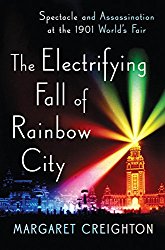Margaret Creighton effectively weaves together narratives of both notorious and forgotten figures in the non-fiction historical, The Electrifying Fall of Rainbow City: Spectacle and Assassination at the 1901 World’s Fair.
Buffalo, New York, the eighth largest city in America at the turn of the century, launched the Pan American Exposition. With electricity drawn from nearby Niagara Falls, the 350 acres was resplendent with colorful lights, buildings painted with every color in the rainbow, paved streets and exhibits from all over the world. After the usual struggles and hassles over funding and coordinating, the fair opened May 1 and ended November 2, 1901.
Creighton follows much of the fair’s progress through a school teacher’s account, the true-life character of Mabel Barnes, who visited the fair 34 times and kept meticulous detailed journals of her visits.
Niagara Falls was a big drawing card with people riding over the falls in barrels, some with disastrous results, some who lived to tell about it.
President William McKinley, the 25th president of the United States was a highlight of the fair. He gave a speech and in part said: “Expositions are the timekeepers of progress. They record the world’s advancement. They stimulate the energy, enterprise, and intellect of the people; and quicken human genius. They go into the home. They broaden and brighten the daily life of the people. They open mighty storehouses of information to the student.”
President McKinley’s role in the Exposition took a tragic turn when he was shot by an anarchist, Leon Czolgosz on September 6, 1901 at the Temple of Music. The President died eight days later on September 14 from gangrene caused by the bullet wounds. The author goes into some detail about the deranged assassin.
Two other astonishing acts are featured with some detail: a little person known as the Doll Lady, and a huge elephant, Jumbo II, the largest animal in captivity, both of whom turned the tables on their cruel managers.
In reading this bit of history, I again realized how far we have come in our treatment of animals. Animals shows, with their wild animals tamed by whips, starvation, even electrical current, was hard to read. Putting African Americans and Native Americans “on display” also went against the grain. The comparison between yesteryear and today gives hope toward future equality and fair treatment.
The Electrifying Fall of Rainbow City: Spectacle and Assassination at the 1901 World’s Fair is a satisfying read. I had known only tidbits about this Exposition and found Creighton’s account fascinating. The book is well documented with footnotes.



I agree that animal neglect/mistreatment is tough to read. But any of your reviews are so well written, I am once again enticemented.
You know, Judith, I can remember going to a circus and being enthralled with the “wild” animals. We’ve come so far in recognizing the cruelty in this.
Wow, that sounds fascinating and upsetting at the same time. I’m interested, though, because my present works in progress are set in 1900 to 1903. I like to have a feel for the times, even if my setting and characters are different.
THANKS!
Irene
It’s a treasure regarding the period of time. I had known some of the story, but not all the detail. I particularly liked the idea of so much of the information coming from a teacher who attended so many times.